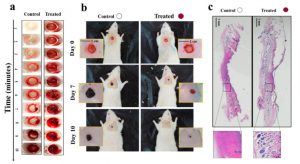Usage of Hydrogels in Wound Healing
Written by: Shiqi Cheng
Recently, hydrogels, a type of water-filled polymer, have been found to be a useful material for effective wound healing, which this article will explore.
Injuries to Human Skin
The skin is the largest organ in the human body and acts as a useful physical barrier that keeps humans alive. It allows the body to retain water and maintain homeostasis while also deflecting toxic substances. The three layers normal skin possesses are the epidermis (external barrier), the dermis (main structural layer), and the hypodermis (fat storage). Wound healing to these skin layers consists of four overlapping phases: homeostasis, inflammation, proliferation, and maturation. In the first few minutes after an injury, blood platelets will begin to stick together and fibrin is activated to form a mesh to prevent further blood loss. During the inflammatory phase, immune cells gather at the wound site and absorb bacteria, pathogens, dead cells, and other debris. Afterwards, during proliferation, fibroblasts (a cell that creates collagen and other fibers) multiply to cover the wound site. Finally, epithelial cells migrate to the wound edges to cover any remaining defects. While skin has self-regenerating properties, injuries to the skin that are larger than a certain diameter aren’t able to heal by itself, thus, requiring skin transplants.

Figure 1
Diagrams depicting the four step (homeostasis, inflammation, proliferation, and maturation) process of wound healing.
Source: US National Library of Medicine
Common Skin Injury Treatment Methods
The most used method to treat skin wounds today are skin grafts, where a patch of skin is surgically removed from one area of the body and transplanted to the injured area. However, this is often not a viable method when there is extensive skin loss or immune rejection. Additionally, skin grafts can cause lots of pain and scarring with slow healing times. Other methods include skin flaps, tissue expansion techniques, and dermal substitutes. A skin flap is when healthy skin in a local area is used to cover a nearby wound and remains connected to a blood vessel. Tissue expansion involves growing extra skin by inserting a silicone balloon expander underneath the skin to encourage stretching. Dermal substitutes involve biologically engineered material (composed of collagen and glycosaminoglycans) which is able to act as scaffolds and promote new tissue growth. Recently, hydrogels have drawn attention as a skin injury treatment method due to their unique ability to mimic the skin microenvironment.
Using Hydrogels
The word “hydrogels” refers to the class of materials used in soft tissue engineering of skin, muscle, blood vessels, and fat. Hydrogels are insoluble and made up of hydrophilic polymers. This allows them to effectively absorb wound exudates while also allowing oxygen diffusion which increases healing times. Hydrogels are also highly soluble which allows them to maintain high moisture levels and morph into any shape. With all of these traits, hydrogels provide an environment that promotes tissue regeneration and are very biocompatible. These advantages are seen in in-vitro experimentation where a nanocomposite hydrogel dressing based on polydopamine modified ZnO was used. This hydrogel spray, combined with antibacterial dressing, facilitated rapid wound closure as seen in Figure 2.

Figure 2
ZnO based hydrogel spray on wounds in mice demonstrates faster and better healing.
Source: National Center for Biotechnology Information
Conclusion
Overall, hydrogels are materials with a lot of potential in the field of wound healing. Their ability to imitate human skin and support wound healing are currently found to be very significant in in-vitro experimentation. This has a lot of applications in the medical field and can improve the quality of life for people that suffer from large open wounds.
References and Sources
Tavakoli, Shima, and Agnes S Klar. “Advanced Hydrogels as Wound Dressings.” Biomolecules, MDPI, 11 Aug. 2020, www.ncbi.nlm.nih.gov/pmc/articles/PMC7464761/.
Gupta, B., et al. “Hydrogels for Wound Healing Applications.” Biomedical Hydrogels, 2011, pp. 184–227., doi:10.1533/9780857091383.2.184.
AM;, Mogoşanu GD;Grumezescu. “Natural and Synthetic Polymers for Wounds and Burns Dressing.” International Journal of Pharmaceutics, U.S. National Library of Medicine, pubmed.ncbi.nlm.nih.gov/24368109/.